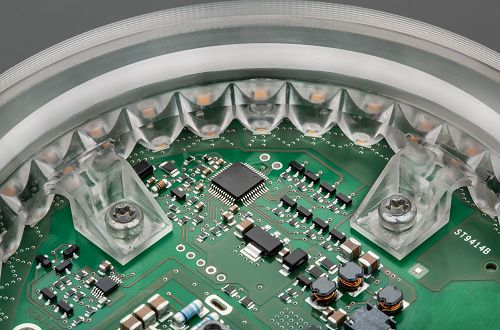|
|
|
|
|
|
|
|
Inspection and test procedures in product development
20-07-2022Our conviction: we’ve got the highest product quality! This is the objective which we set ourselves – and which we strive to turn into reality every day anew. We define demanding, internal quality criteria that apply throughout the entire development and manufacturing process. Test procedures and quality observations often go beyond what is required. Learn more about the individual test procedures that our lighting and electronics products have to undergo.
The key points in short
- As early as the development stage, continuous tests are carried out, which are then kept up during production.
- The test procedures include checking resistance to spray and salt water, to dust and also to high-pressure jet cleaning.
- Great importance is also attached to thermal tests evaluating heat and cold resistance.
- Wide-ranging physical simulations such as drop and vibration tests and also force testing and continuous operation performance ensure the functionality of each individual product under conditions of stress and strain.
Heat, humidity and cold tests
Products are often exposed to severe temperature fluctuations and changing levels of humidity. In order to ensure that the products can cope with such challenges, we simulate extreme operating conditions: in temperature cycle tests, HELLA products are exposed to temperature fluctuations from -40 °C to +100 °C in climatic chambers, which have a volume of between 600 to 1,000 litres. In addition, condensation and de-icing tests are carried out up to max. 95% air humidity and up to 80 °C. In the so-called "shock cabinet", the temperature varies within seconds (intervals of max. 6 seconds) between -40 °C and +100 °C. The duration of the heat and cold tests lasts up to 48 hours.
The rain-light sensor in the cold test.
Splash test
Splashes or spray, caused by, for example, vehicles driving ahead, presents one of the most common environmental conditions for our products. Therefore we test this, too, by simulating real requirements – and by using special universal splash water cabins. The cabins are equipped with devices for rain, splash water, water jets and water mist. During water cycle and spray water tests, the test products are then exposed to a pressure of up to 5 bar and in the water jet test to a pressure of up to 10 bar to check their leak tightness.
High-pressure jet cleaner test
During high-pressure jet cleaning, the vehicles and vehicle parts are subjected to partially extreme pressure. This can reach as high as 120 bar. As a comparison: in a normal household water pressure usually gets to between 0.5 and 5 bar. In one test facility using extreme water pressure and a water temperature of +85 °C, car wash-style cleaning or cleaning with a high-pressure jet cleaner is reliably simulated.
High-pressure jet cleaner test for the LED daytime running and position lamp 90 mm
Vibration test
Bad paths with potholes, differing surfaces such as gravel, stones and farm tracks: vibrations and shocks are part of everyday life for many products. The wide band random vibration test is used to test the mechanical endurance strength in the vertical and horizontal axes. The frequency range extends here from 10 to 1000 Hertz. Temperature overlap ranging from -40 °C to+80 °C simulates, in addition, the real ageing process of the plastic. All products are tested for correct functioning for up to 24 hours. During this process, a mechanical shock test is also performed. This simulates what would happen if there were impact (products in packaging during shipping) with an acceleration of between 300 and 500 metres per second squared. Incidentally, for selected products such as auxiliary headlamps, special rally profiles are also tested.
Vibration test for the LED daytime running and position lamp 90 mm
Dust test
Dust pollution frequently creates negative environmental conditions. This is, of course, particularly the case with work carried out in the fields or on building sites. So for that reason we perform extensive tests to check how dustproof our products are. For this quality check, unfired Portland cement is used as a test medium. The test can be performed in a sample function operation and also with overpressure or underpressure exposure in the tested device. The tests are evaluated by determining, amongst other things, the photometric value before and after the test. Only products fulfilling all requirements are given the internal quality approval.
Dust test on the rotary actuator for high forces
Immersion and pressure tightness tests
Many HELLA products are also subjected to immersion and pressure tightness tests. An immersion pipe can be submerged in water up to a depth of 1 metre. Another test system can reach a depth of 6 metres. Furthermore, an overpressure test up to 1.6 bar is conducted in an immersion pool. All tests are carried out in accordance with HELLA standards and also it goes without saying that they are performed on the basis of legal requirements.
Immersion and leak test for a work lamp.
You can find more information about the product range here.




